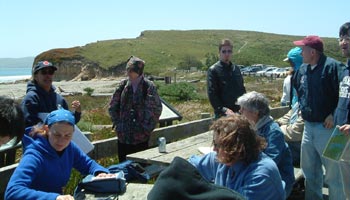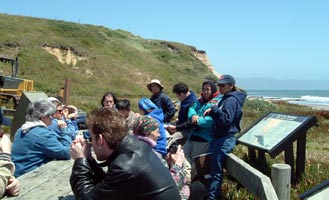Drake's Beach provided a beautiful place to
stop for lunch, followed by a discussion of the Purisima Formation. |
|
|
Geologic History: |
| 1. Sedimentation: |
| 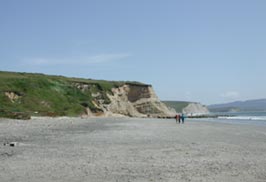
|
In contrast to the conglomerates we viewed at
Stop #2, the Purisima Formation (mapped as the Drakes Bay Formation
in older reports) is a fine-grained marine sedimentary deposit
that is latest Miocene to Pliocene in age (6-3 million years
old). It was deposited on the continental shelf and upper slope
when sea level rose after the accumulation of the Pt. Reyes
Conglomerate. The Purisima Formation occurs in other coastal
outcrops in San Mateo and San Cruz counties and varies a lot
in composition, texture, and abundance of fossils. |
| 2. Paleontology: |
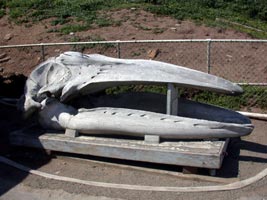
|
The Purisima Formation at Drakes Bay is a
diatomaceous (diatom microfossil-bearing) siltstone and fine
sandstone with thin interbeds of mudstone. Although macroinvertebrate
and vertebrate fossils are rare in this exposure, the Purisima
Formation is known to be rich in bivalves, gastropods, echinoderms,
sharks teeth, and marine mammal fossils. Sedimentary structures
visible here include burrows (bioturbation) and faint cross
bedding. |
| 3. Uplift,
Weathering and Erosion: |
| The Purisima Formation records the last marine
phase of deposition of units on top of granite bedrock (Salinian
block). The entire block was uplifted as it was transported
northward along the San Andreas fault resulting in the exposures
along the Pt. Reyes shoreline. The Purisima Formation displays
a number of structures that formed in response to uplift, such
as jointing and fracturing. |
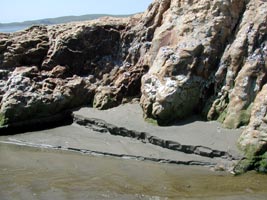 |
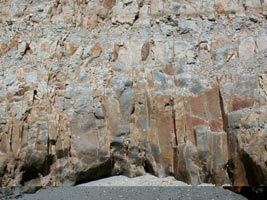
|
Also visible are many interesting weathering
features including iron staining, color banding, and differential
weathering of carbonate concretions. |
|
